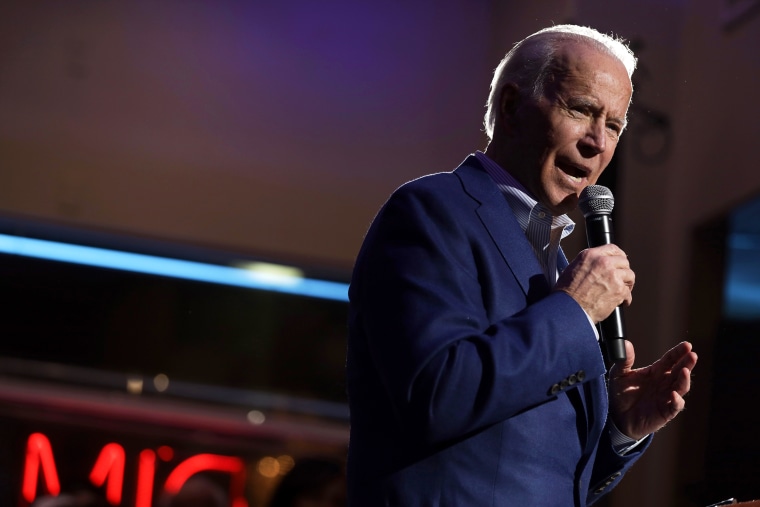Asian American members of Congress are teaming up with Joe Biden’s campaign for an initiative to reach out to Asian American and Pacific Islander (AAPI) voters.
The lawmakers will join the official AAPIs for Biden group on a virtual bus tour, with a plan to make roughly 10 stops, including many in battleground states, over the course of two weeks, NBC Asian America first reported. Their aim is to connect with the AAPI electorate in those areas, the campaign announced Wednesday.
Rep. Grace Meng, who is joining the tour, said the primary goal is to drive voter registration, educate voters, and pull more people into their organizing universe.
The initiative, titled “AAPIs Assemble! Virtual Bus Tour with ASPIRE PAC,” is launched in partnership with the political arm of the Congressional Asian Pacific American Caucus. It is slated to kick off Friday in Milwaukee with additional stops announced in the coming days. The campaign said that it is working with the state teams to provide translators for multiple languages at the events, based on the AAPI communities the tour will reach.
The events are, in part, an effort to reach voters and communities who were often forgotten by campaigns in the past, Meng said. She acknowledged that the Democratic Party has historically not been as proactive as she feels it should be in reaching Asian American voters. According to the 2020 Asian American Voter Survey, roughly 50 percent of Asian Americans reported that they were not contacted by the Democratic Party while an even higher portion, 55 percent, said that Republicans had not reached out to them.
But the voting bloc should not be easy to ignore. It remains the fastest growing electorate compared to all other major races and ethnicities, according to Pew Research. In the past two decades, it has ballooned 139 percent. And during the 2018 midterms, researchers found that the group had the ability to swing elections in roughly 27 congressional districts, spanning 11 states. The lawmaker said that she is “constantly trying to emphasize” that the community holds undeniable influence in the political sphere.
Meng, who is a vice chair of the Democratic National Committee, said that her own involvement with the committee was heavily influenced by the lack of outreach to AAPI in battleground and Southern states.
“I don't think enough Democrats appreciate our community,” Meng said. “I would love to say they take us for granted, but I don't even think that we've been on their minds in many cases.”
When candidates do put forth resources to appeal to the Asian American electorate, the work yields results. Meng cited candidates like Jon Ossoff, who became the Democratic nominee for the 2020 Georgia Senate election, and Rep. Gil Cisneros of California, an incumbent running for re-election, as individuals who have engaged the community in a genuine way.
“These are races where they recognize the power and influence of the local Asian communities. And they have worked closely with them, and they have won,” Meng said. “You can see that, of course, they care about our issues, but they're also there because they know that their constituents have woken up, and that a significant number of their constituents are Asian American.”
Engaging Asian Americans can be tricky, Meng acknowledges. The group has a lower civic participation rate compared to some others, with a 42 percent voter turnout rate in 2018. In comparison, the group lagged behind the Black community who had a turnout rate of 51 percent. Paul Ong, a research professor at the UCLA Luskin School of Public Affairs, previously explained that because the Asian American community is comprised of mostly immigrants, many have to engage in multiple steps of political acculturation including naturalization and registration before they even get to vote.
“Naturalization often requires learning a new language, as well as American history and civics. Many come from countries where political engagement is discouraged, culturally and by the powerful,” he said. “It is not just the immigrants, but also their children because political education starts at home.”
Meng said that this is why she feels that building trust in local Asian American communities is key to getting them to the ballot. She added that doing on-the-ground work such as talking to people on the streets and engaging them in their own personal circles are crucial for turnout. She said she also spends time dispelling myths about the political system and teaching, particularly newer immigrants, about how to be involved.
“It's just a lot of education and a lot of relationship building, she said. “When I'm on the street, registering a voter and asking someone if they want to register as a Democrat, depending on what country they're from, they don't understand what that means. They don't understand what it means to become a member of the party. They think they have to pay dues, sometimes they think they have to attend meetings.”
The lawmaker also said that many immigrants are primarily focused on survival and attaining stability in the U.S. Being politically involved isn’t necessarily a priority for them. Gaining trust and ensuring more representation in the political sphere can change attitudes, she believes.
“I think having Asian candidates help from every level of government, whether you're running for the most local office, or whether you're running for president like Andrew Yang,” Meng said. “We need people from our communities to be in the room where they're having these types of discussions.”
